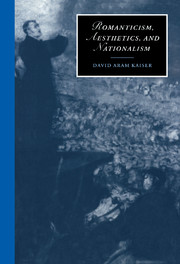Book contents
- Frontmatter
- Contents
- Acknowledgements
- List of abbreviations
- Introduction
- 1 Modernity, subjectivity, liberalism, and nationalism
- 2 The symbol and the aesthetic sphere
- 3 Schiller's aesthetic state
- 4 Symbol, state, and Clerisy: the aesthetic politics of Coleridge
- 5 The best self and the private self: Matthew Arnold on culture and the state
- 6 Aesthetic kingship and queenship: Ruskin on the state and the home
- 7 The aesthetic and political spheres in contemporary theory: Adorno and Habermas
- Notes
- Index
4 - Symbol, state, and Clerisy: the aesthetic politics of Coleridge
Published online by Cambridge University Press: 22 September 2009
- Frontmatter
- Contents
- Acknowledgements
- List of abbreviations
- Introduction
- 1 Modernity, subjectivity, liberalism, and nationalism
- 2 The symbol and the aesthetic sphere
- 3 Schiller's aesthetic state
- 4 Symbol, state, and Clerisy: the aesthetic politics of Coleridge
- 5 The best self and the private self: Matthew Arnold on culture and the state
- 6 Aesthetic kingship and queenship: Ruskin on the state and the home
- 7 The aesthetic and political spheres in contemporary theory: Adorno and Habermas
- Notes
- Index
Summary
THE PROJECT OF “CHURCH AND STATE”
In chapter 2, I analyzed Coleridge's theo-philosophical account of the symbol in The Statesman's Manual. In his last published prose work, On the Constitution of the Church and State, According to the Idea of Each (1830), Coleridge presents an account of the English Constitution using the logic of the symbol, and ascribes to the national church (what he calls the Clerisy) the role of the aesthetic sphere. The genesis of Church and State was an immediate political issue, the pending bill for the emancipation of Irish Catholics. But Coleridge uses that issue as a jumping-off point to present a systematic culmination of his mature political philosophy, which he had been developing from articles in the periodical Friend of 1809 through The Statesman's Manual of 1816. Church and State presents Coleridge's response to the crises that England was experiencing as the result of industrialization and other aspects of modernization, the forces that Coleridge identifies with the word progression: “Roads, canals, machinery, the press, the periodical and daily press, the might of public opinion” (C&S, 29).
As his title announces, Coleridge sets out to explain the ideas behind the British state and its national church. Coleridge's argument is that the church and the state had initially been unified according to the originary idea of the constitution, but that the forces of modernization had split these two institutions apart. This split is reflected in the discrepancy between the spirtual and material progress of the nation.
- Type
- Chapter
- Information
- Romanticism, Aesthetics, and Nationalism , pp. 59 - 73Publisher: Cambridge University PressPrint publication year: 1999



